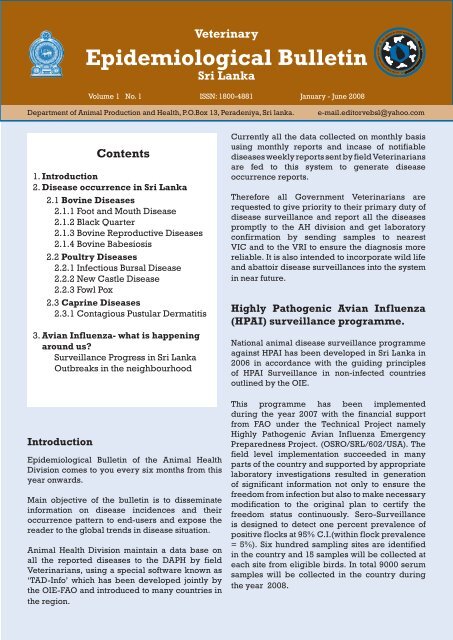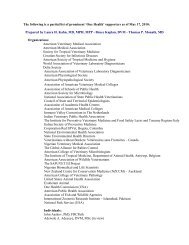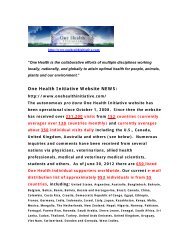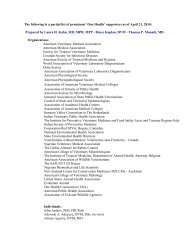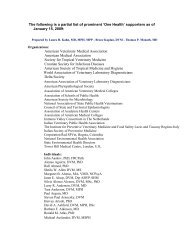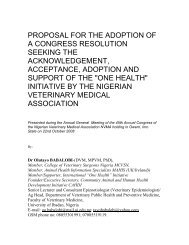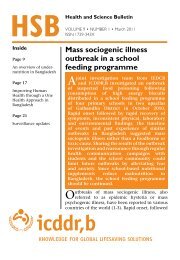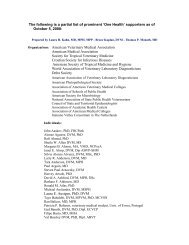Veterinary Epidemiological Bulletin Sri Lanka - One Health Initiative
Veterinary Epidemiological Bulletin Sri Lanka - One Health Initiative
Veterinary Epidemiological Bulletin Sri Lanka - One Health Initiative
You also want an ePaper? Increase the reach of your titles
YUMPU automatically turns print PDFs into web optimized ePapers that Google loves.
<strong>Veterinary</strong><br />
<strong>Epidemiological</strong> <strong>Bulletin</strong><br />
<strong>Sri</strong> <strong>Lanka</strong><br />
Department of Animal Production and <strong>Health</strong>, P.O.Box 13, Peradeniya, <strong>Sri</strong> lanka. e-mail.editorvebsl@yahoo.com<br />
Introduction<br />
<strong>Epidemiological</strong> <strong>Bulletin</strong> of the Animal <strong>Health</strong><br />
Division comes to you every six months from this<br />
year onwards.<br />
Main objective of the bulletin is to disseminate<br />
information on disease incidences and their<br />
occurrence pattern to end-users and expose the<br />
reader to the global trends in disease situation.<br />
Animal <strong>Health</strong> Division maintain a data base on<br />
all the reported diseases to the DAPH by field<br />
Veterinarians, using a special software known as<br />
‘TAD-Info’ which has been developed jointly by<br />
the OIE-FAO and introduced to many countries in<br />
the region.<br />
Vet.Epid.<strong>Bulletin</strong>e SL Vol.1 No.1<br />
Volume 1 No. 1 ISSN: 1800-4881<br />
January - June 2008<br />
Contents<br />
1. Introduction<br />
2. Disease occurrence in <strong>Sri</strong> <strong>Lanka</strong><br />
2.1 Bovine Diseases<br />
2.1.1 Foot and Mouth Disease<br />
2.1.2 Black Quarter<br />
2.1.3 Bovine Reproductive Diseases<br />
2.1.4 Bovine Babesiosis<br />
2.2 Poultry Diseases<br />
2.2.1 Infectious Bursal Disease<br />
2.2.2 New Castle Disease<br />
2.2.3 Fowl Pox<br />
2.3 Caprine Diseases<br />
2.3.1 Contagious Pustular Dermatitis<br />
3. Avian Influenza- what is happening<br />
around us?<br />
Surveillance Progress in <strong>Sri</strong> <strong>Lanka</strong><br />
Outbreaks in the neighbourhood<br />
Currently all the data collected on monthly basis<br />
using monthly reports and incase of notifiable<br />
diseases weekly reports sent by field Veterinarians<br />
are fed to this system to generate disease<br />
occurrence reports.<br />
Therefore all Government Veterinarians are<br />
requested to give priority to their primary duty of<br />
disease surveillance and report all the diseases<br />
promptly to the AH division and get laboratory<br />
confirmation by sending samples to nearest<br />
VIC and to the VRI to ensure the diagnosis more<br />
reliable. It is also intended to incorporate wild life<br />
and abattoir disease surveillances into the system<br />
in near future.<br />
Highly Pathogenic Avian Influenza<br />
(HPAI) surveillance programme.<br />
National animal disease surveillance programme<br />
against HPAI has been developed in <strong>Sri</strong> <strong>Lanka</strong> in<br />
2006 in accordance with the guiding principles<br />
of HPAI Surveillance in non-infected countries<br />
outlined by the OIE.<br />
This programme has been implemented<br />
during the year 2007 with the financial support<br />
from FAO under the Technical Project namely<br />
Highly Pathogenic Avian Influenza Emergency<br />
Preparedness Project. (OSRO/SRL/602/USA). The<br />
field level implementation succeeded in many<br />
parts of the country and supported by appropriate<br />
laboratory investigations resulted in generation<br />
of significant information not only to ensure the<br />
freedom from infection but also to make necessary<br />
modification to the original plan to certify the<br />
freedom status continuously. Sero-Surveillance<br />
is designed to detect one percent prevalence of<br />
positive flocks at 95% C.I.(within flock prevalence<br />
= 5%). Six hundred sampling sites are identified<br />
in the country and 15 samples will be collected at<br />
each site from eligible birds. In total 9000 serum<br />
samples will be collected in the country during<br />
the year 2008.
. . Reported cases of Foot and Mouth Disease: January – June 008<br />
Fig: 4 January Fig: 5 February Fig: 6 March<br />
Fig: 4 April Fig: 5 May Fig: 6 June<br />
District VS Range Species Cases Deaths Month<br />
Anuradhapura Thirappane Buffalo 20 2 January<br />
Padawiya Bovine 975<br />
Buffalo 300<br />
Kahatagasdigiliya Buffalo 10<br />
Gampaha Meerigama Bovine 11<br />
Anuradhapura Horowupothana Bovine 14 February<br />
Rambewa Bovine 40<br />
Buffalo 10<br />
Puttalam Wanathavillu Bovine 5 1<br />
Kurunegala Udubaddawa Swine 10<br />
Bovine 20<br />
Anuradhapura Horowupothana Caprine 2 March<br />
Kandy Gampola Bovine 12<br />
Anuradhapura Horowupothana Bovine 4 April<br />
Kahatagasdigiliya Buffalo 88<br />
Bovine 44<br />
Caprine 8<br />
Mullaitivu Tunukkai Bovine 4 May<br />
Anuradhapura Kahatagasdigiliya Buffalo 3<br />
Bovine 14<br />
Galenbindunuwewa Bovine 14<br />
Medawachchiya Bovine 4<br />
Anuradhapura Galenbindunuwewa Bovine 5 June<br />
Horowupothana Bovine 110 4<br />
Kahatagasdigiliya Buffalo 8<br />
Ratnapura Weligepola Buffalo 21 13<br />
Kilinochchi Karachchi Bovine 87 65<br />
Vavuniya Vavuniya South Bovine 40 2<br />
<strong>Sri</strong> <strong>Lanka</strong> 16 Rranges/23 outbreaks Bov,Cap,Sui 1883 87<br />
The only sero type of Foot and mouth virus<br />
believed to be existing in <strong>Sri</strong> <strong>Lanka</strong> is the<br />
Serotype “o”. However, it has to be confirmed<br />
in all outbreaks by laboratory in order to ensure<br />
the existence of this serotype exclusively.<br />
Vet.Epid.<strong>Bulletin</strong>e SL Vol.1 No.1
. . Reported cases of Black Quarter: January – June 008<br />
Fig:7<br />
Vet.Epid.<strong>Bulletin</strong>e SL Vol.1 No.1<br />
Table: 0 : Distribution of Reported BQ Cases<br />
District VS Range Species Cases Deaths Month<br />
Polonnaruwa Bakamuna Bovine 2 2 February<br />
Anuradhapura Horowupothana Bovine 1 April<br />
Trincomalee Kantale Bovine 7 5 June<br />
3 3 Bovine 10 7<br />
. . Infectious Reproductive<br />
Diseases in Cattle<br />
Bovine Brucellosis and<br />
Leptospirosis have been<br />
detected causing abortions in<br />
cattle.<br />
Bovine brucellosis among<br />
cattle have been detected<br />
in Nachchaduwa ( 2 cases)<br />
and CNP Nuwaragam Palatha<br />
Central (1 cases) <strong>Veterinary</strong><br />
ranges in Anuradhapura District<br />
during the month of April while<br />
Leptospirosis was detected in<br />
Galnewa (6 cases ; 3 deaths ) in<br />
Jan .& Feb. and Bibile (2cases)<br />
in April.<br />
. .4 Reported cases of Bovine Babesiosis : January – June 008<br />
Fig:8 Bovine Babesiosis<br />
These data suggest Bovine Babesiosis, the<br />
disease of Hill country animals is now spreading<br />
in other low line areas too.Is it due to the change<br />
Table 0 : Monthly distribution of Bovine Babesiosis<br />
Month Cases Deaths<br />
January 127 6<br />
February 126 2<br />
March 108 3<br />
April 184 9<br />
May 111 1<br />
June 161 4<br />
in behavior of the Babesia parasite or the<br />
change in the susceptibility of cattle because<br />
of the genetic improvement?.
. . Reported cases of Infectious Bursal Disease: January – June 008<br />
Fig : 9 January Fig : 10 February Fig: 11 March<br />
Cases 371<br />
Deaths 115<br />
Fig: 12 April Fig: 13 May Fig: 14 June<br />
Cases 559<br />
Deaths 236<br />
Infectious Bursal Disease (Gumboro disease)<br />
remains the major disease affecting poultry<br />
population in the country. Though there is high<br />
incidence in defined period, the occurrence<br />
is reported throughout the year in significant<br />
Cases 987<br />
Deaths 336<br />
Cases 1363<br />
Deaths 355<br />
Cases 2024<br />
Deaths 447<br />
Cases 1545<br />
Deaths 1247<br />
level. The outbreaks are reported mostly in<br />
poultry belt area in the North-Western and<br />
Western Provinces. However, the clinical cases<br />
are recorded in the North-Central Province<br />
during the period of six months continuously<br />
. . Reported cases of Newcastle Disease: January – June 008<br />
Fig: 15 January Fig:16 February Fig:17 March<br />
Cases 39<br />
Deaths 28<br />
Cases 33<br />
Deaths 28<br />
Cases 75<br />
Deaths 61<br />
4 Vet.Epid.<strong>Bulletin</strong>e SL Vol.1 No.1
. . Reported cases of Newcastle Disease: January – June 008<br />
Fig:18 April Fig:19 May Fig:20 June<br />
Cases 54<br />
Deaths 36<br />
Newcastle disease (Raniket disease) appears<br />
to be effectively controlled among commercial<br />
poultry population due to stringent vaccination<br />
regime adhered in commercial farms. The<br />
incidence in backyard poultry in which the<br />
preventive vaccination is rarely carried<br />
out remains threat to the entire poultry<br />
population.<br />
Vet.Epid.<strong>Bulletin</strong>e SL Vol.1 No.1<br />
Cases 32<br />
Deaths 22<br />
. . Reported Cases of Fowl Pox : January – June 008<br />
Cases 108<br />
Deaths 19<br />
Clinical cases of Newcastle disease need to<br />
be investigated and confirmed by laboratory<br />
testing since it is essential to prove the<br />
disease and rule out any possible evidence of<br />
suspected Avian Influenza infection especially<br />
in backyard population<br />
Fig:21 January Fig:22 February Fig:23 March<br />
Cases 236<br />
Deaths 44<br />
Cases 256<br />
Deaths 43<br />
Cases 142<br />
Deaths 11<br />
Fig : 24 April Fig: 25 May Fig: 26 June<br />
Cases 185<br />
Deaths 17<br />
Cases 253<br />
Deaths 22<br />
Cases 175<br />
Deaths 25
. . Reported cases of Contagious Pustular Dermatitis: January – June 008<br />
Contagious Pustular Dermatitis (CPD) is a major<br />
infectious disease among goats and reported<br />
mostly in Anuradhapura and Polonnaruwa<br />
Districts where goat raring activities are<br />
District Cases Deaths<br />
Ampara 29 2<br />
Anuradhapura 204 5<br />
Colombo 4<br />
Hambanthota 10<br />
Kandy 25<br />
Kurunegala 65<br />
Matale 86 12<br />
Monaragala 1<br />
Monaragala 13<br />
Mullaitivu 1<br />
Polonnaruwa 98 5<br />
Puttalam 81<br />
Ratnapura 4<br />
Trincomalee 20<br />
Vavuniya 10<br />
Total 651 24<br />
. AVIAN INFLUENZA - what is happening around us?<br />
Global Situation: January – June 2008<br />
WAHID OIE © 2008<br />
RESOLVED<br />
CONTINUING<br />
popular and promoted. Auto vaccine is<br />
prepared in the <strong>Veterinary</strong> Investigation<br />
centers and it contributes to arrest the spread<br />
of this infection<br />
Vet.Epid.<strong>Bulletin</strong>e SL Vol.1 No.1
In <strong>Sri</strong> <strong>Lanka</strong> - HPAI Surveillance Progress: January – June 008 07<br />
District<br />
No: of<br />
Location<br />
Targeted<br />
Colombo 45<br />
Vet.Epid.<strong>Bulletin</strong>e SL Vol.1 No.1<br />
No: of samples<br />
collected<br />
No: of<br />
samples<br />
tested<br />
Testing in<br />
progress<br />
Gampaha 36 105 105<br />
Kalutara 32<br />
Kandy 42 120 120<br />
Matale 16<br />
No: of +ve<br />
Reactors<br />
Nuwaraeliya 7 30 30 0<br />
Galle 11<br />
Matara 8 120 120<br />
Hambantota 9 90 90<br />
Jaffna 21<br />
Kilinochhi 7<br />
Mannar 5<br />
Vavuniya 5<br />
Mullativu 6<br />
Batticaloa 12<br />
Ampara 13<br />
Trincomalee 8<br />
Kurunegala 157 390 390 184<br />
Puttalam 69 205 205<br />
Anuradhapura 21 93 60 12<br />
Polonnaruwa 7 120 120 6<br />
Badulla 8 45 45 7<br />
Monaragala 4 30 30<br />
Ratnapura 18 105 105<br />
Kegalle 13 60 15 45 15<br />
Total 80 0 80<br />
. *Serum samples are screened for Avian<br />
Influenza type, A virus antibodies by Enzyme<br />
linked immunosorbent assay (ELISA). Samples<br />
which develop positive reaction are further<br />
subjected to Agar gel precipitation test<br />
(AGPT) to detect antibodies against H5. H7 or<br />
H9 antigen. There has been no sample found<br />
to be positive for AGPT and as such it reveals<br />
that there is no adequate evidence to support<br />
the circulation of Avian Influenza virus among<br />
the chicken population
HPAI Outbreaks in the neighbourhood<br />
Highly pathogenic avian influenza - India<br />
Information received on 14/07/2008 from Dr<br />
Pradeep Kumar, Secretary to the Government<br />
of India, Department of Animal Husbandry,<br />
DairyingandFisheries,MinistryofAgriculture,<br />
New Delhi, India<br />
HPAI broke out in India (West Bengal and<br />
Tripura States) in the Border of Bangladesh<br />
in January 2008. In a population of 8.6 million<br />
poultry in these areas, 127,912 cases were<br />
detected with 1005 case-fatality rate. Further<br />
Measures applied in control / eradication Operation<br />
•<br />
•<br />
•<br />
•<br />
•<br />
•<br />
•<br />
•<br />
Stamping out<br />
Quarantine<br />
Movement control inside the country<br />
Screening<br />
Disinfection of infected premises/establishment(s)<br />
Dipping / Spraying<br />
No vaccination<br />
No treatment of affected animals<br />
Contact Details:<br />
4.33 million birds were destroyed in the<br />
operation of stamping out of all domestic<br />
poultry in an approximately 5-km-radius<br />
area around these 42 outbreaks followed by<br />
compensation of the owners. However, the<br />
disease lingered on for almost five months and<br />
H5N1 serotype of Avian Influenza type A virus<br />
has been confirmed by real-time PCR at High<br />
Security Animal Disease Laboratory, Bhopal<br />
(National laboratory of India).<br />
Director Animal <strong>Health</strong> Chief Epidemiologist<br />
Dr.H.M.A.Chandrasoma Dr. Ranjani Hettiarachchi<br />
T.P 0812388317 Fax 0812388317<br />
Editor,<br />
Dr Ravi Bandara Dissanayake,<br />
Animal <strong>Health</strong> Division,<br />
Department of Animal production & <strong>Health</strong>,<br />
P.O Box 13,Peradeniya.<br />
ravibandara@yahoo.com<br />
8 Vet.Epid.<strong>Bulletin</strong>e SL Vol.1 No.1<br />
PRINTED AT KANDY OFFSET PRINTERS LTD +94 81 2389 880


